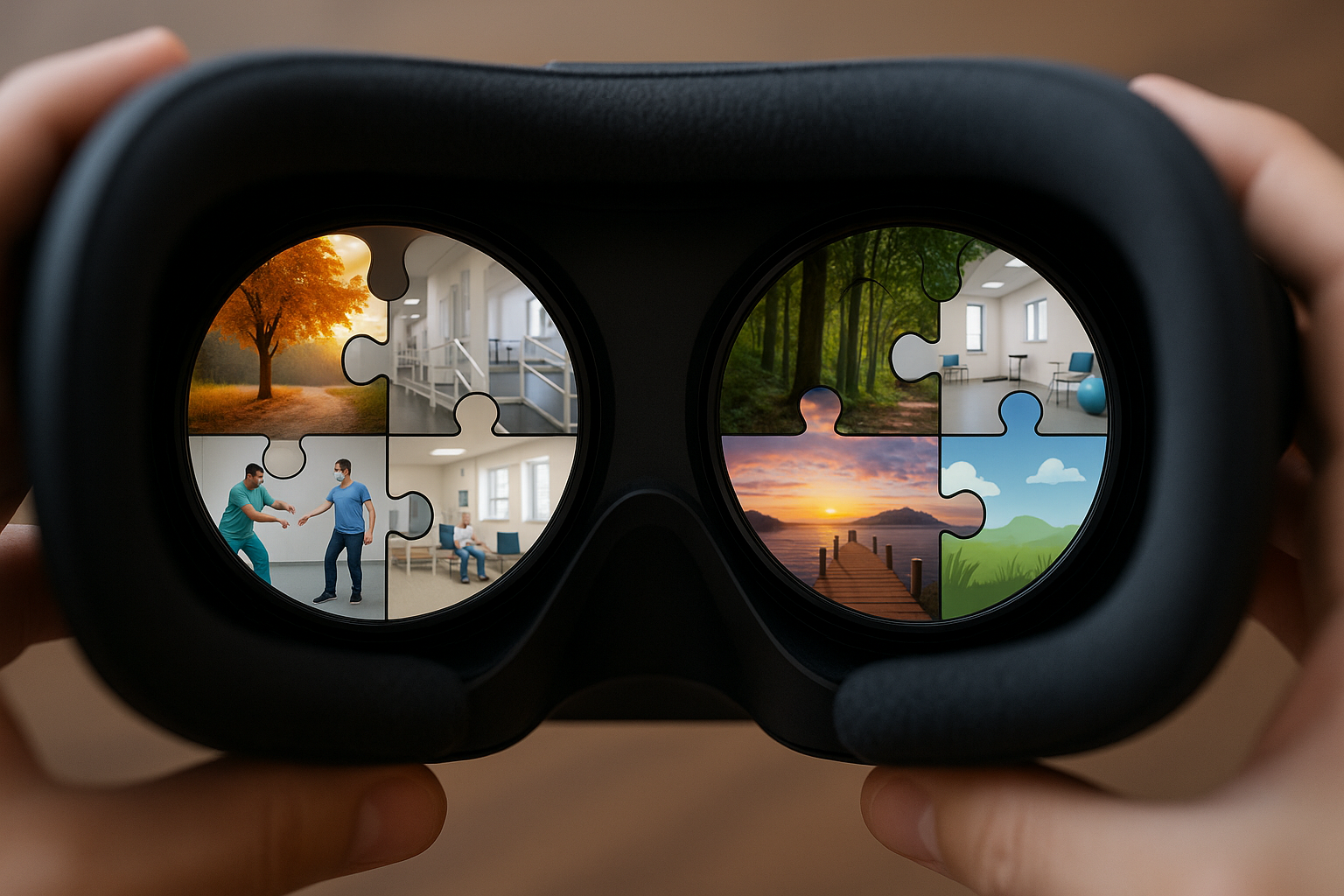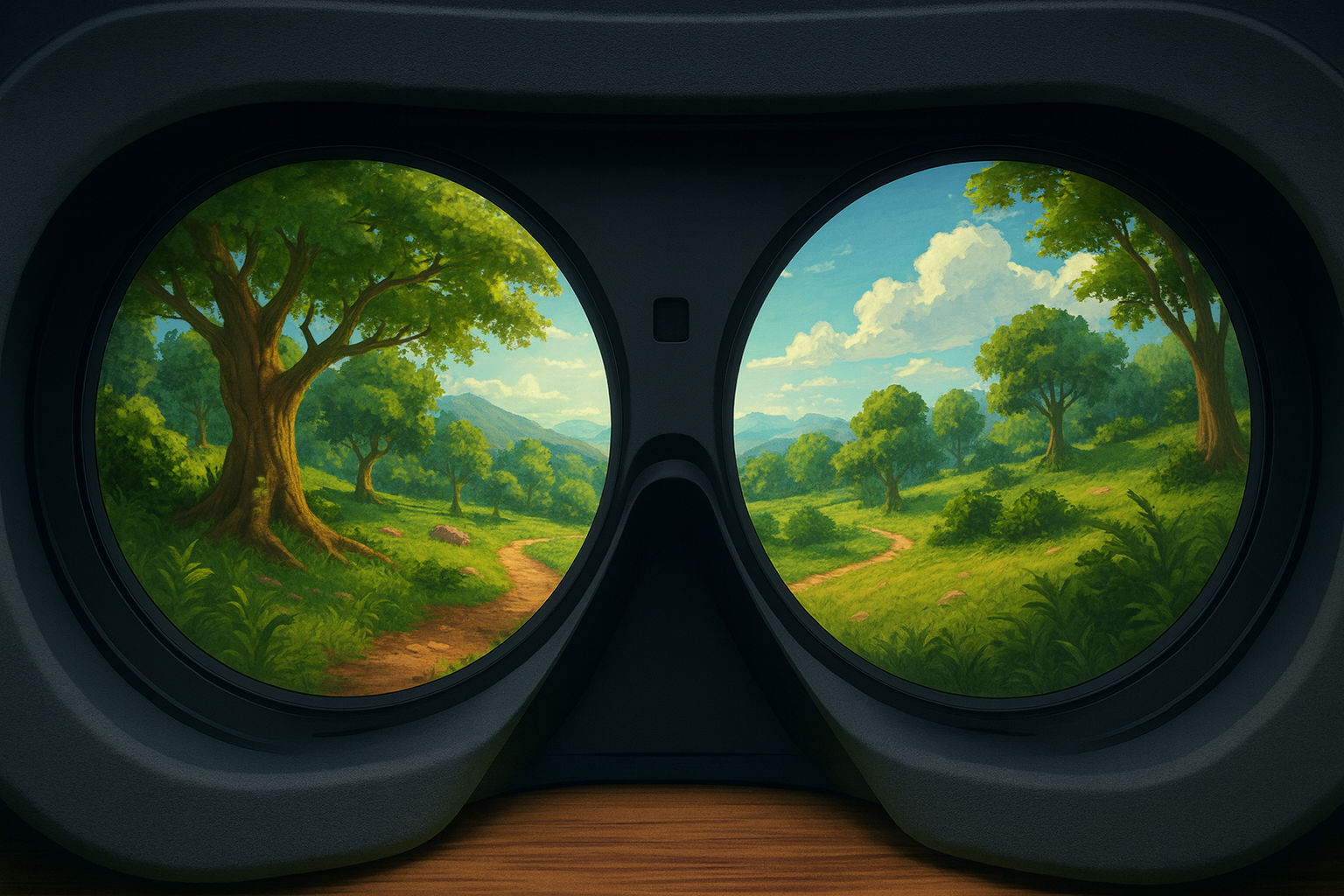Rehab Reimagined Blogs & Research

Why XR Will Become a Standard of Care in the Next 10 Years
In rehabilitation, we are entering a new phase of innovation. This shift is not about replacing clinicians but enhancing how we deliver care. Extended Reality (XR), which includes virtual, augmented, and mixed reality, is moving rapidly from a “nice-to-have” to a “necessary” tool in modern therapy.

Breathing, Relaxation, and Pain Distraction: Evidence-Based Approaches in VR
In practice, I have seen this effect firsthand. One patient, confined to bed and relying on narcotic pain medication, initially resisted therapy because his pain was overwhelming. Once immersed in a distraction-based VR environment, his focus shifted entirely. His breathing slowed, his muscles softened, and his expression changed. Within minutes, his reported pain dropped from a 9 to a 2. When the nurse returned with his next medication dose, he declined it, saying he finally felt ready to get up and walk. This moment captured what the data shows: distraction through immersion is not avoidance; it is engagement through relief.

What Traditional Rehab Gets Right and Where XR Can Help Bridge the Gaps
After 14 years in the clinic, I’ll be the first to say: traditional rehab works. I’ve seen firsthand how skilled therapy changes lives. I’ve also seen the barriers: limited time, fatigue, disengagement, and access challenges. That is why I believe XR is not here to replace what already works; it is here to build on it. With the right design, XR can extend therapy beyond the walls of the clinic, make practice more engaging, and open the door to possibilities we could not reach before. I am confident that the future of rehab lies in this blend of proven foundations and innovative tools, and that future looks incredibly hopeful.

Why Content Is the Missing Piece in XR Healthcare
At AVRwell, we are addressing the challenge of limited content by building an XR ecosystem that is both clinically rigorous and universally accessible. Our applications are designed to work across all-in-one medical XR platforms as well as off-the-shelf headsets, ensuring that clinics can access the same high-quality, evidence-based library no matter which devices they choose. This flexibility allows therapists to integrate XR seamlessly into their workflow, without compromise.

The Art of the First Session: What We Learn from Watching Patients Enter XR for the First Time
There’s a moment, right after the headset slips on, when everything changes.
A quiet gasp. Eyes widen as they take in the immersive world around them. The patient turns their head, scanning every corner of the new environment. Excitement replaces hesitation. A hand reaches forward, testing possibility. In that instant, motivation stirs, the body leans in, ready to try, to accomplish what once felt out of reach in the real world.
At AVRwell, we’ve come to treasure this moment. It happens during that very first XR session, when a patient steps into immersive therapy for the first time. In those first few minutes, we see more than awe; we see the spark of possibility. And in that spark, we learn how to build better tools, for this person, and for every patient who will follow.

The Best Feedback We’ve Ever Gotten From a Patient
In the world of rehabilitation, we measure success in small steps: improved range of motion, better balance, reduced pain, improved independence, renewed focus. But sometimes, the most powerful outcomes can’t be charted on a graph. Sometimes, they come in the form of a simple, heartfelt phrase from a patient who’s just turned a corner.
One of those moments will stay with us forever.
“I feel capable again.”
Those four words came from a man who had every reason to believe he wouldn’t feel that way again.

Where XR Wellness Applications Fit in the Corporate World
In recent years, corporate wellness programs have evolved far beyond gym discounts and occasional mindfulness workshops. Many companies now recognize that supporting employee health is not only a moral responsibility but also a smart business strategy, reducing burnout, preventing injuries, and boosting productivity. With immersive extended reality (XR) technologies like those developed by AVRwell, there is an opportunity to take these programs to a new level.

The New Age of XR in Healthcare: How AVRwell Is Redefining Rehabilitation
AVRwell was founded by a team of clinicians, developers, and XR industry veterans with deep experience designing therapeutic tools for hospitals and clinics. Our mission is to create immersive content that is not only engaging, but also informed by clinical research and rooted in principles that support real recovery.

Introducing the AVRwell XR Relief Suite
We’re excited to announce that the XR Relief Suite is now available for facilities and XR health platforms managing devices through MDMs like ArborXR and ManageXR.
Originally developed by our team at Penumbra in collaboration with clinicians at the VA, and deployed across VA facilities, these apps are now accessible to providers and platforms on Quest 3 and 3S.

From Patient Care to Platform Creation: Why I Left the Clinic to Build XR Tools for Rehab
For over a decade, I worked as a Physical Therapist—shoulder to shoulder with patients who were fighting some of the biggest battles of their lives. Stroke survivors learning to walk again. Traumatic brain injury patients working to regain balance. Individuals struggling with dizziness, double vision, or post-concussion symptoms just trying to feel “normal” again.
To this day, I remember every single one of them. Their faces. Their stories. Their breakthroughs and setbacks. I often find myself wondering how they’re doing now—hoping they’re living fuller, more independent lives. Every one of them still holds a special place in my heart.
Helping people heal became a part of my identity long before I ever stepped into a non-clinical role.

How Remote XR Therapy Is Revolutionizing Rehabilitation Access and Outcomes
There are moments in healthcare innovation when technology doesn’t just support clinical practice—it redefines it. The surge of remote Extended Reality (XR) therapy and telerehabilitation is one of those pivotal shifts. Across disciplines like stroke rehabilitation, cognitive therapy, and balance training, clinicians and researchers are witnessing a transformation in how, where, and when rehabilitation happens.

Leveling Up in Real Life: How Gamified XR is Helping Us Heal
Let’s be honest: healing can be boring and frustrating.
Whether you're recovering from an injury, dealing with stress, or just trying to improve your wellness game, the path to feeling better often feels like grinding for XP in a game with no storyline, no rewards, and way too many loading screens (hello, waiting rooms).
But what if recovery could feel like playing your favorite game? What if you could level up your real life health stats while battling digital dragons, tracking turtles, or shooting targets in a virtual world?
Welcome to the world of gamified XR (Extended Reality), where physical and mental wellness gets a power-up, gamer-style.

XR in Rehab: What’s New in 2025 and Why It Matters for Reimbursement
XR is reshaping rehabilitation, no longer a novel tool, it’s evolving into a core component of modern physical and occupational therapy. As clinics grow more comfortable with immersive tech, 2025 marks a pivotal moment: the conversation is shifting from “does it work?” to “how do we pay for it?”

Can VR Help Patients with Alzheimer’s Disease? A Curious Dive into an Emerging Therapeutic Possibility
As someone deeply engaged in neurorehabilitation, I've seen firsthand how virtual reality (VR) can support brain plasticity, spark motivation, and encourage functional recovery in conditions like stroke, traumatic brain injury, and vestibular disorders. These experiences often lead me to wonder, if VR can make such a difference in these areas, could it also offer something meaningful to individuals living with Alzheimer’s Disease (AD)?

Exploring the Future of XR in Rehab: Thank You, A.T. Still University
This past week, I had the incredible opportunity to speak at A.T. Still University and engage with a passionate group of future clinicians about a subject close to my heart: the role of extended reality (XR) in rehabilitation. I want to extend my deepest thanks to the students and faculty who welcomed me so warmly. It was not only an honor to teach but also a joy to witness the curiosity, insight, and enthusiasm that filled the room.

AVRwell and Invincikids Unite to Enhance Children's Access to XR Therapy
We’re excited to announce our collaboration with Invincikids, a nonprofit organization dedicated to transforming pediatric healthcare experiences through immersive technology. Together, we're introducing a suite of XR therapy applications designed to support children during and after medical treatments, aiming to make their healthcare journeys more engaging, intuitive, and research-informed.

Combating Depression with Virtual Reality: Emerging Therapies and Outcomes
Mental health challenges are often an invisible but profound consequence of injury, illness, and trauma. As a physical therapist, I see firsthand how patients grappling with new limitations often experience significant emotional distress. The loss of independence, changes in lifestyle, and disruption of personal identity can contribute to feelings of depression. Supporting patients' mental health is not only compassionate care; it is essential to achieving the best possible physical recovery outcomes. Virtual reality (VR) is emerging as a powerful tool in mental health support, offering new, evidence-based pathways for healing and hope.

Bringing Back Independence: How Virtual Reality Is Helping Stroke Survivors Reclaim Their Lives
As we recognize National Stroke Awareness Month, it’s the perfect time to shine a light on the evolving tools that are giving stroke survivors new ways to rebuild their independence. One of the most exciting advancements is immersive technology, particularly Virtual Reality (VR) and Augmented Reality (AR).

Bridging the Gap: Clinician Perspectives on Integrating Virtual Reality into Therapy
In recent years, virtual reality (VR) has gained momentum as a powerful tool in rehabilitation settings. Yet, despite a growing body of evidence supporting its efficacy, successful VR adoption in physical and occupational therapy often hinges on more than just the technology itself — it depends on clinician leadership. Understanding therapists' experiences and perceptions is essential for making VR a meaningful, sustainable addition to patient care.

The Expanding Role of Virtual Reality in Neuro Rehab: Why AVRwell is on the Right Path
In my journey as a Physical Therapist, I’ve always believed in the power of innovation, especially when it has the potential to redefine independence for our patients. Over the last five years, I've witnessed how Virtual Reality (VR) has emerged not just as a novel adjunct to care, but as a transformative tool for patients across a wide range of conditions, from vestibular disorders and neurologic impairments to chronic pain, mobility limitations, and difficulties with functional daily tasks.

